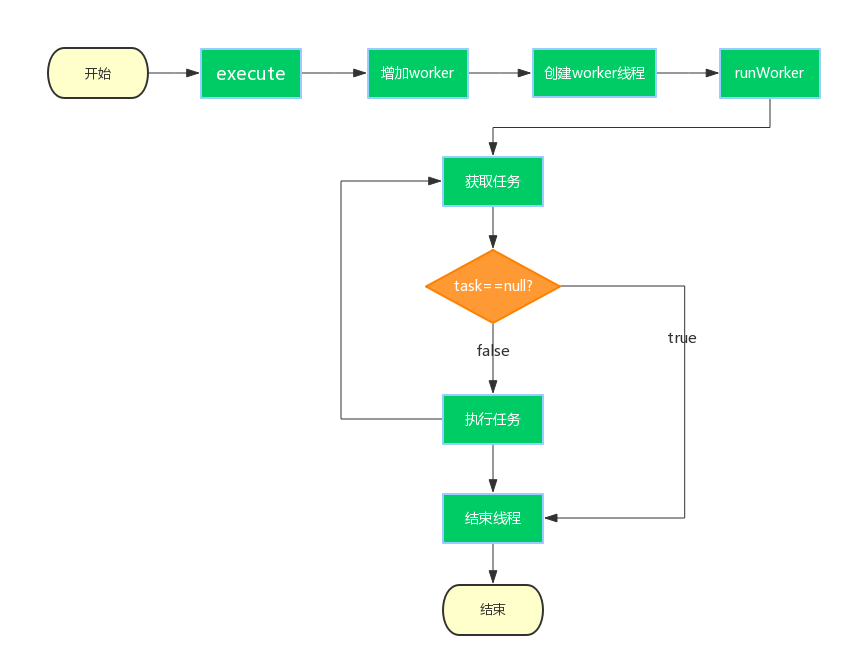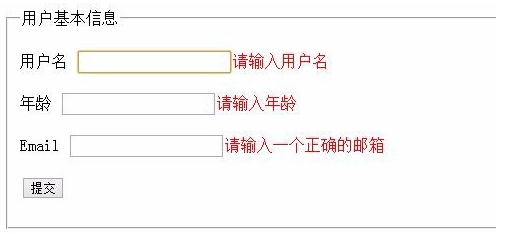Java多线程进阶(十五):线程池的使用
为什么要使用线程池
- 创建/销毁线程需要消耗系统资源,线程池可以复用已创建的线程。
- 控制并发的数量。并发数量过多,可能会导致资源消耗过多,从而造成服务器崩溃。(主要原因)。
- 可以对线程做统一管理。
线程池的原理
Java中的线程池顶层接口是Executor接口,ThreadPoolExecutor是这个接口的实现类。
我们先看一下
Executor。public interface Executor {
/*** Executes the given command at some time in the future. The command* may execute in a new thread, in a pooled thread, or in the calling* thread, at the discretion of the {@code Executor} implementation.** @param command the runnable task* @throws RejectedExecutionException if this task cannot be* accepted for execution* @throws NullPointerException if command is null*/void execute(Runnable command);
}
我们再看看
ThreadPoolExecutor类。构造函数如下:// 五个参数的构造函数
public ThreadPoolExecutor(int corePoolSize,int maximumPoolSize,long keepAliveTime,TimeUnit unit,BlockingQueue<Runnable> workQueue)
// 六个参数的构造函数-1
public ThreadPoolExecutor(int corePoolSize,int maximumPoolSize,long keepAliveTime,TimeUnit unit,BlockingQueue<Runnable> workQueue,ThreadFactory threadFactory)
// 六个参数的构造函数-2
public ThreadPoolExecutor(int corePoolSize,int maximumPoolSize,long keepAliveTime,TimeUnit unit,BlockingQueue<Runnable> workQueue,RejectedExecutionHandler handler)
// 七个参数的构造函数
public ThreadPoolExecutor(int corePoolSize,int maximumPoolSize,long keepAliveTime,TimeUnit unit,BlockingQueue<Runnable> workQueue,ThreadFactory threadFactory,RejectedExecutionHandler handler)
关于构造函数的参数的含义
- int corePoolSize:该线程池中核心线程数最大值
核心线程:线程池中有两类线程,核心线程和非核心线程。核心线程默认情况下会一直存在于线程池中,即使这个核心线程什么都不干(铁饭碗),而非核心线程如果长时间的闲置,就会被销毁(临时工)。
- int maximumPoolSize:该线程池中线程总数最大值 。
该值等于核心线程数量 + 非核心线程数量。
- long keepAliveTime:非核心线程闲置超时时长。
非核心线程如果处于闲置状态超过该值,就会被销毁。
- TimeUnit unit:keepAliveTime的单位。
- BlockingQueue workQueue:阻塞队列,维护着等待执行的Runnable任务对象。
常用的几个阻塞队列:
- LinkedBlockingQueue
链式阻塞队列,底层数据结构是链表,默认大小是Integer.MAX_VALUE,也可以指定大小。
- ArrayBlockingQueue
数组阻塞队列,底层数据结构是数组,需要指定队列的大小。
- SynchronousQueue
同步队列,内部容量为0,每个put操作必须等待一个take操作,反之亦然。
- DelayQueue
延迟队列,该队列中的元素只有当其指定的延迟时间到了,才能够从队列中获取到该元素 。
- 线程池主要的任务处理流程
处理任务的核心方法是execute,我们看看 JDK 1.8 源码中ThreadPoolExecutor是如何处理线程任务的:
public void execute(Runnable command) {if (command == null)throw new NullPointerException();// clt 记录着runState workerCountint c = ctl.get();// 1.当前线程数小于corePoolSize,则调用addWorker创建核心线程执行任务if (workerCountOf(c) < corePoolSize) {if (addWorker(command, true))return;c = ctl.get();}// 2.如果不小于corePoolSize,则将任务添加到workQueue队列。if (isRunning(c) && workQueue.offer(command)) {int recheck = ctl.get();// 2.1 如果isRunning返回false(状态检查),则remove这个任务,然后执行拒绝策略。if (! isRunning(recheck) && remove(command))reject(command);// 2.2 线程池处于running状态,但是没有线程,则创建线程else if (workerCountOf(recheck) == 0)addWorker(null, false);}// 3.如果放入workQueue失败,则创建非核心线程执行任务,// 如果这时创建非核心线程失败(当前线程总数不小于maximumPoolSize时),就会执行拒绝策略。else if (!addWorker(command, false))reject(command);}
总结一下处理流程
- 线程总数量 < corePoolSize,无论线程是否空闲,都会新建一个核心线程执行任务(让核心线程数量快速达到corePoolSize,在核心线程数量 < corePoolSize时)。注意,这一步需要获得全局锁。
- 线程总数量 >= corePoolSize时,新来的线程任务会进入任务队列中等待,然后空闲的核心线程会依次去缓存队列中取任务来执行(体现了线程复用)。
- 当缓存队列满了,说明这个时候任务已经多到爆棚,需要一些“临时工”来执行这些任务了。于是会创建非核心线程去执行这个任务。注意,这一步需要获得全局锁。
缓存队列满了, 且总线程数达到了maximumPoolSize,则会采取拒绝策略进行处理。
- 线程池四种拒绝策略
当线程池的任务缓存队列已满并且线程池中的线程数目达到maximumPoolSize,如果还有任务到来 就会采取任务拒绝策略。RejectedExecutionHandler接口定义如下
public interface RejectedExecutionHandler {void rejectedExecution(Runnable r, ThreadPoolExecutor executor);}
通过源码可以看到,线程池一共有四种拒绝策略,如下图所示
ThreadPoolExecutor.AbortPolicy是线程池的默认决绝策略,丢弃任务并抛出RejectedExecutionException异常。
public static class AbortPolicy implements RejectedExecutionHandler {/*** Creates an {@code AbortPolicy}.*/public AbortPolicy() { }/*** Always throws RejectedExecutionException.** @param r the runnable task requested to be executed* @param e the executor attempting to execute this task* @throws RejectedExecutionException always*/public void rejectedExecution(Runnable r, ThreadPoolExecutor e) {throw new RejectedExecutionException("Task " + r.toString() +" rejected from " +e.toString());}}
ThreadPoolExecutor.DiscardPolicy的策略是丢弃任务,但是不抛出异常。
public static class DiscardPolicy implements RejectedExecutionHandler {/*** Creates a {@code DiscardPolicy}.*/public DiscardPolicy() { }/*** Does nothing, which has the effect of discarding task r.** @param r the runnable task requested to be executed* @param e the executor attempting to execute this task*/public void rejectedExecution(Runnable r, ThreadPoolExecutor e) {}}
ThreadPoolExecutor.DiscardOldestPolicy的策略是丢弃队列最前面的任务,然后重新尝试执行任务并重复此过程。
public static class DiscardOldestPolicy implements RejectedExecutionHandler {/*** Creates a {@code DiscardOldestPolicy} for the given executor.*/public DiscardOldestPolicy() { }/*** Obtains and ignores the next task that the executor* would otherwise execute, if one is immediately available,* and then retries execution of task r, unless the executor* is shut down, in which case task r is instead discarded.** @param r the runnable task requested to be executed* @param e the executor attempting to execute this task*/public void rejectedExecution(Runnable r, ThreadPoolExecutor e) {if (!e.isShutdown()) {e.getQueue().poll();e.execute(r);}}}
ThreadPoolExecutor.CallerRunsPolicy的策略是由调用线程处理该任务。
public static class CallerRunsPolicy implements RejectedExecutionHandler {/*** Creates a {@code CallerRunsPolicy}.*/public CallerRunsPolicy() { }/*** Executes task r in the caller's thread, unless the executor* has been shut down, in which case the task is discarded.** @param r the runnable task requested to be executed* @param e the executor attempting to execute this task*/public void rejectedExecution(Runnable r, ThreadPoolExecutor e) {if (!e.isShutdown()) {r.run();}}}
- 线程池如何实现复用
可以先看一下线程池复用的流程图,接下来我们通过源码对线程复用的原理做详细的分析。
ThreadPoolExecutor在创建线程时,会将线程封装成工作线程worker,并放入工作线程组中,然后这个worker反复从阻塞队列中拿任务去执行。
简单的说,线程池就是一组工人,任务是放在队列Queue里,一共就这么几个工人,当有空闲的工人,就会去队列里领取下一个任务,所以通过这种手段限制的总工人(线程)数量,即为复用。接下来我们通过源码来分析一下线程池复用的原理。
首先看一下ThreadPoolExecutor.addWorker
private boolean addWorker(Runnable firstTask, boolean core) {//...这里有一段CAS代码,通过双重循环目的是通过CAS增加线程池线程个数boolean workerStarted = false;boolean workerAdded = false;Worker w = null;try {w = new Worker(firstTask);final Thread t = w.thread;//...省略部分代码workers.add(w);//...省略部分代码workerAdded = true;if (workerAdded) {t.start();workerStarted = true;}}}
源代码比较长,这里省略了一部分。过程主要分成两步,第一步是一段CAS代码通过双重循环检查状态并为当前线程数扩容 +1,第二部是将任务包装成worker对象,用线程安全的方式添加到 HashSet() 里,并开始执行线程。
接下来看一下Worker的部分源码。Worker类实现了Runnable接口,所以Worker也是一个线程任务。在构造方法中,创建了一个线程,线程的任务就是自己。故addWorker方法中的t.start,会触发Worker类的run方法被JVM调用。
private final class Worker extends AbstractQueuedSynchronizer implements Runnable{final Thread thread;Runnable firstTask;Worker(Runnable firstTask) {setState(-1); // inhibit interrupts until runWorkerthis.firstTask = firstTask;// 新建一个线程this.thread = getThreadFactory().newThread(this);}public void run() {runWorker(this);}//其余代码略...}
继续来看runWorker()方法
final void runWorker(Worker w) {Thread wt = Thread.currentThread();Runnable task = w.firstTask;w.firstTask = null;w.unlock(); // allow interruptsboolean completedAbruptly = true;//省略代码while (task != null || (task = getTask()) != null) {//省略代码try {beforeExecute(wt, task);Throwable thrown = null;try {task.run();} catch (Exception x) {thrown = x; throw x;}//省略代码}//省略代码}
这里有一个大的while循环,当我们的task不为空的时候它就永远在循环,并且会源源不断的调用getTask()来获取新的任务,然后调用task.run()执行任务,从而达到复用线程的目的。
继续跟踪getTask()方法,这里主要是在workQueue中拉取任务
private Runnable getTask() {boolean timedOut = false; // Did the last poll() time out?for (;;) {//..省略// Are workers subject to culling?boolean timed = allowCoreThreadTimeOut || wc > corePoolSize;//..省略try {Runnable r = timed ?workQueue.poll(keepAliveTime, TimeUnit.NANOSECONDS) :workQueue.take();if (r != null)return r;timedOut = true;} catch (InterruptedException retry) {timedOut = false;}}}
以上源码就是线程池复用的整个流程。总结一下最核心的一点就是:新建一个Worker内部类就会建一个线程,并且会把这个内部类本身传进去当作任务去执行,这个内部类的run方法里实现了一个while循环,当任务队列没有任务时结束这个循环,则这个线程就结束。
常见的线程池
newSingleThreadExecutor
public static ExecutorService newSingleThreadExecutor() {
return new FinalizableDelegatedExecutorService(new ThreadPoolExecutor(1, 1,0L, TimeUnit.MILLISECONDS,new LinkedBlockingQueue<Runnable>()));
}
有且仅有一个核心线程( corePoolSize == maximumPoolSize=1),使用了LinkedBlockingQueue(容量很大),所以,不会创建非核心线程。所有任务按照先来先执行的顺序执行。如果这个唯一的线程不空闲,那么新来的任务会存储在任务队列里等待执行。
newFixedThreadPool
public static ExecutorService newFixedThreadPool(int nThreads) {
return new ThreadPoolExecutor(nThreads, nThreads,0L, TimeUnit.MILLISECONDS,new LinkedBlockingQueue<Runnable>());
}
核心线程数量和总线程数量相等,都是传入的参数nThreads,所以只能创建核心线程,不能创建非核心线程。因为LinkedBlockingQueue的默认大小是Integer.MAX_VALUE,故如果核心线程空闲,则交给核心线程处理;如果核心线程不空闲,则入列等待,直到核心线程空闲。
newCachedThreadPool
public static ExecutorService newCachedThreadPool() {
return new ThreadPoolExecutor(0, Integer.MAX_VALUE,60L, TimeUnit.SECONDS,new SynchronousQueue<Runnable>());
}
运行流程如下:
- 提交任务进线程池。
- 因为corePoolSize为0的关系,不创建核心线程,线程池最大为Integer.MAX_VALUE。
- 尝试将任务添加到SynchronousQueue队列。
- 如果SynchronousQueue入列成功,等待被当前运行的线程空闲后拉取执行。如果当前没有空闲线程,那么就创建一个非核心线程,然后从SynchronousQueue拉取任务并在当前线程执行。
- 如果SynchronousQueue已有任务在等待,入列操作将会阻塞。
当需要执行很多短时间的任务时,CacheThreadPool的线程复用率比较高, 会显著的提高性能。而且线程60s后会回收,意味着即使没有任务进来,CacheThreadPool并不会占用很多资源。
- newScheduledThreadPool
创建一个定长线程池,支持定时及周期性任务执行。
public static ScheduledExecutorService newScheduledThreadPool(int corePoolSize) {return new ScheduledThreadPoolExecutor(corePoolSize);}//ScheduledThreadPoolExecutor():public ScheduledThreadPoolExecutor(int corePoolSize) {super(corePoolSize, Integer.MAX_VALUE,DEFAULT_KEEPALIVE_MILLIS, MILLISECONDS,new DelayedWorkQueue());}


































还没有评论,来说两句吧...